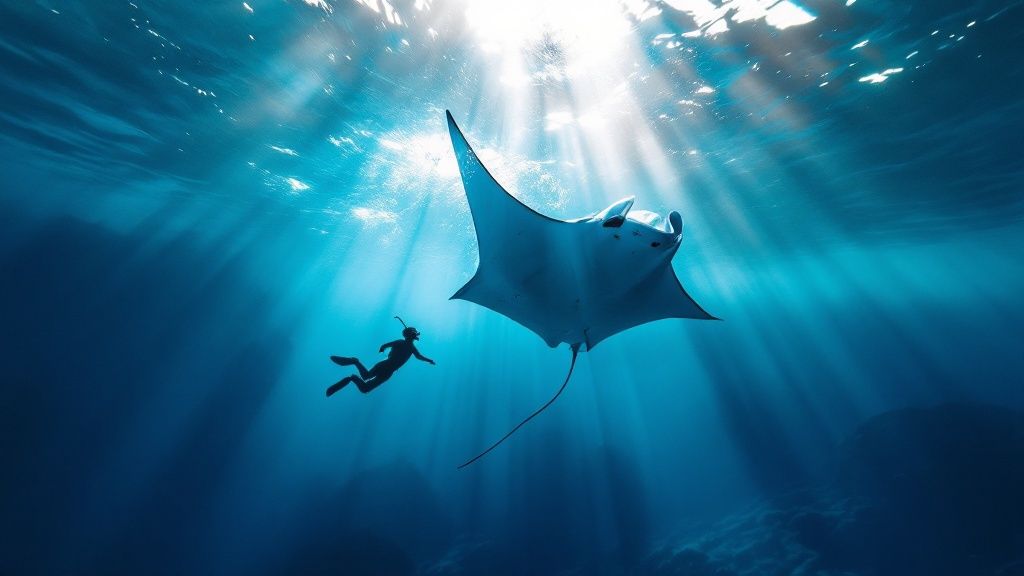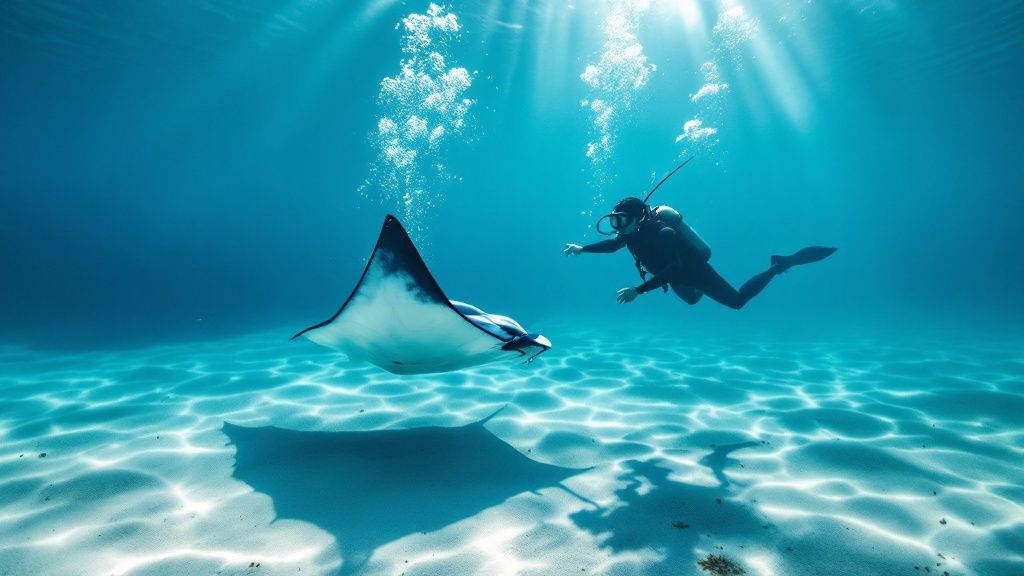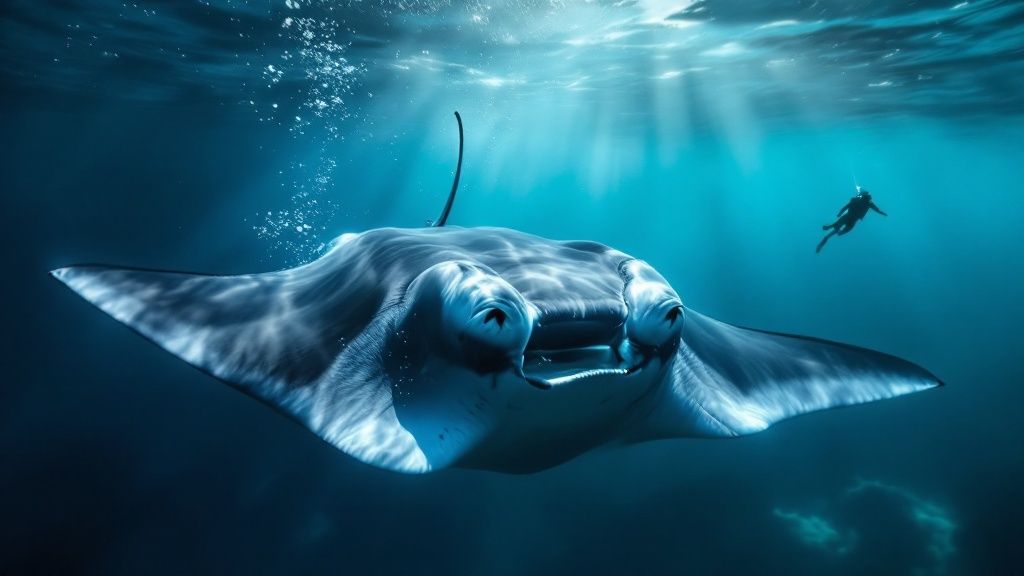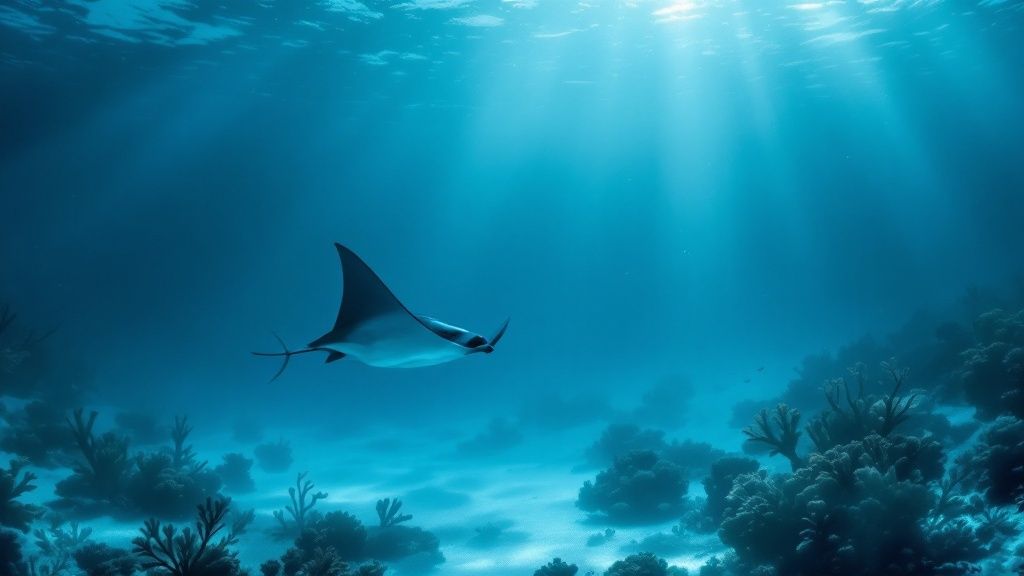Ultimate Manta Ray Snorkeling Adventure

The Unforgettable Magic of Manta Ray Snorkeling

There's something truly special about drifting in the inky blackness of the ocean, waiting for the dark, graceful forms of manta rays to appear. Manta ray snorkeling offers a unique and often profoundly moving adventure, attracting ocean lovers worldwide. This isn't your average snorkeling trip; it's a chance to connect with the elegance and intelligence of these gentle giants.
Floating on the surface, you'll be amazed as these magnificent creatures glide through the water. It's an experience that stays with you long after you leave the ocean.
Observing Feeding Behaviors
One of the most captivating aspects of manta ray snorkeling is witnessing their feeding habits. These graceful animals, despite their impressive size, dine primarily on tiny plankton. They navigate the water with effortless grace, creating mesmerizing swirling motions as they filter feed.
This elegant ballet creates an incredible spectacle for snorkelers lucky enough to witness it. It's a reminder of the beauty and complexity of the ocean's ecosystem.
Manta Ray Intelligence
The intelligence of manta rays adds another dimension to the experience. They are known to recognize individual people and will often approach snorkelers with what seems like genuine curiosity. This interaction builds a connection that surpasses the typical wildlife encounter.
It transforms a simple snorkeling trip into a memorable, meaningful experience. Many snorkelers describe their time with manta rays as a deeply moving encounter, sparking a new appreciation for ocean life.
The Economic Impact of Manta Ray Tourism
The rising popularity of manta ray snorkeling has had a positive impact on conservation efforts. The global economic benefit of manta ray watching tourism is substantial, generating an estimated $140 million in annual revenue. This includes direct spending and related tourism activities across ten key countries. Find more detailed statistics here
This income supports local economies and encourages the protection of manta rays, especially in areas where they face threats from fishing. This economic leverage is essential for promoting sustainable practices that benefit both local communities and these magnificent creatures.
Choosing the Right Snorkeling Operator
Choosing a responsible tour operator is crucial for a positive manta ray snorkeling experience. Reputable companies like Kona Honu Divers, Manta Ray Night Snorkel Hawaii, Kona Snorkel Trips, and Captain Cook Snorkeling Tours prioritize safety and conservation. These experienced operators understand the importance of minimizing disruption to the manta rays and their habitat.
They often use techniques like underwater lighting to attract plankton, which brings the manta rays closer to the surface for better viewing. This allows for close-up encounters without interfering with the mantas' natural feeding behavior, enhancing the overall snorkeling adventure.
World-Class Destinations for Manta Ray Encounters

Manta ray snorkeling is an unforgettable experience, but not all locations are created equal. This section explores some of the best places worldwide to encounter these graceful giants. Let's dive in!
The Kona Coast: Nighttime Manta Ray Magic
The Kona coast of Hawaii is renowned for its unique nighttime manta ray snorkeling. Submerged lights attract plankton, drawing the manta rays closer to the surface. This creates an unparalleled opportunity for close-up viewing.
Several local operators offer guided tours, including Kona Honu Divers, Manta Ray Night Snorkel Hawaii, and Captain Cook Snorkeling Tours. These tours offer a truly special experience, allowing snorkelers to observe these gentle giants feeding in their natural habitat.
This nighttime approach also minimizes disturbance to the manta rays' natural behavior. It’s a magical way to observe these creatures up close.
Beyond Hawaii: Global Manta Hotspots
Hawaii might be a popular choice, but numerous other destinations offer fantastic manta ray encounters. The Maldives boast crystal-clear waters and the opportunity to see multiple manta ray species throughout the year.
Komodo National Park in Indonesia offers a different perspective. Here, you can witness the fascinating cleaning rituals of manta rays as they interact with cleaner fish amidst vibrant coral reefs. For more Big Island activities, see Our sitemap.
Other Hidden Gems
For a less crowded experience, consider Tofo Beach in Mozambique or Isla de la Plata in Ecuador. These locations provide exceptional manta ray viewing opportunities with fewer fellow snorkelers. It's a chance to connect with these magnificent creatures in a more intimate setting.
To help you choose the best destination for your manta ray adventure, we've compiled a comparison table:
Top Manta Ray Snorkeling Destinations Comparison
A comprehensive comparison of the world's best locations for manta ray encounters
| Destination | Best Season | Visibility | Encounter Probability | Experience Level Required |
|---|---|---|---|---|
| Kona, Hawaii | Year-round | Excellent (night) | Very High | Beginner |
| Maldives | Year-round | Excellent | High | Beginner to Intermediate |
| Komodo National Park, Indonesia | April-November | Good to Excellent | High | Intermediate |
| Tofo Beach, Mozambique | June-October | Good | Medium to High | Intermediate to Advanced |
| Isla de la Plata, Ecuador | June-September | Good | Medium | Beginner to Intermediate |
This table provides a quick overview of key factors to consider when choosing your destination. Remember to research each location further to determine the best fit for your experience level and travel preferences.
Seasonal Considerations and Local Expertise
Each destination has its own unique characteristics, including seasonal variations in manta ray presence and water clarity. Consulting with local experts and reputable tour operators is essential. These experienced professionals can provide valuable information about the ideal time to visit, optimal viewing conditions, and unique aspects of each location.
For instance, the dry season (generally April to October) typically offers calmer seas and improved visibility in many areas. However, even off-season trips can be rewarding. By understanding these nuances and partnering with seasoned local guides, you can significantly improve your chances of an unforgettable encounter.
Choosing Your Ideal Adventure
Whether you prefer a smaller, more intimate tour or a larger vessel with onboard amenities, the perfect manta ray snorkeling adventure is out there. Choose an operator that prioritizes sustainable tourism and respect for these magnificent creatures. Kona Snorkel Trips is a great option for exploring manta rays on the Big Island, offering tours for all experience levels. Ultimately, careful planning and collaboration with responsible operators will ensure a rewarding and ethical manta ray snorkeling experience.
Crafting Your Perfect Manta Ray Adventure

Planning an unforgettable manta ray snorkeling trip takes more than just booking a flight. It involves careful research and preparation to ensure a memorable and ethical encounter with these gentle giants.
Choosing The Right Operator
Selecting a responsible tour operator is paramount. Look for companies committed to sustainable practices and conservation, like Kona Honu Divers, Manta Ray Night Snorkel Hawaii, Kona Snorkel Trips, and Captain Cook Snorkeling Tours.
These operators prioritize the well-being of the manta rays and their environment. They often employ techniques like underwater lighting to attract plankton, enhancing your viewing experience while minimizing disturbance.
Timing Your Trip: Feeding Cycles and Seasonal Patterns
Understanding the local manta ray feeding cycles is key to a successful snorkeling trip. Consider seasonal variations in manta ray presence and water clarity.
Working with local experts provides valuable insights into the best times to visit for optimal viewing conditions. The dry season, often from April to October, can offer calmer seas and improved visibility in some locations.
Boat Experiences and Budgeting: Options For Every Traveler
Your boat experience significantly impacts your overall adventure. Luckily, there are options for every budget, from affordable group tours to luxurious private charters.
Consider your comfort level and financial constraints. Reviews from past travelers can be incredibly helpful. Whether you prefer a small, intimate setting or a larger vessel with more amenities, finding the right fit is crucial.
Physical Preparation: Gearing Up For Your Underwater Adventure
Preparing physically for different snorkeling conditions ensures a comfortable and enjoyable experience. Practice your snorkeling skills beforehand, especially if you’re a beginner or nervous about night snorkeling.
Consider motion sickness medication if you're prone to seasickness, particularly for longer boat rides. Pack appropriate gear: a wetsuit or rashguard for warmth, towels, and a change of clothes.
Manta ray tourism contributes significantly to local economies. In some regions, it generates over $15 million annually, exceeding revenue from fishing. Explore this topic further. This highlights the economic benefits of marine conservation. For more information, visit our sitemap. Ultimately, a perfect manta ray snorkeling experience comes down to careful planning and supporting operators who prioritize conservation.
What Happens When You Meet Mantas Underwater

From the moment you board the boat, excitement builds for the manta ray snorkeling adventure. Knowledgeable guides, such as those at Kona Snorkel Trips, offer valuable insights into the local manta ray population. This educational approach deepens your appreciation for these incredible creatures before you even enter the water.
Preparing for the Encounter: Safety and Entry
Safety briefings are a crucial first step. Guides explain proper snorkeling techniques and respectful in-water behavior. They also emphasize how a calm water entry minimizes disruption to the manta rays' environment.
This thoughtful approach benefits both the snorkelers and the mantas. Operators like Kona Honu Divers and Manta Ray Night Snorkel Hawaii prioritize these practices. This preparation sets the stage for a positive interaction.
The First Sighting: A Moment of Awe
Then, it happens. A large shadow emerges beneath the waves. The first glimpse of a manta ray is often a truly awe-inspiring moment. Experienced guides help you understand the mantas' behavior. They can interpret the meaning behind their swimming patterns and communication signals.
For instance, a barrel roll usually indicates feeding behavior. A slow, elegant glide suggests a relaxed manta. These observations provide a window into their underwater world.
Connecting With Gentle Giants: Communication and Comfort
Manta rays are intelligent and curious. They often interact with snorkelers, sometimes seeming to recognize familiar faces. Learning to recognize signs of a manta's comfort level enhances the experience.
Slow approaches or lingering near snorkelers can indicate a relaxed manta. Captain Cook Snorkeling Tours provides opportunities to witness these gentle giants up close. Manta ray snorkeling becomes more than just observation; it becomes a connection.
The following table details the differences between daytime and nighttime manta ray snorkeling adventures.
Daytime vs. Night Manta Ray Snorkeling
| Aspect | Daytime Experience | Night Experience | Best For |
|---|---|---|---|
| Visibility | Clear, depending on conditions | Limited, relies on lights to attract plankton and illuminate mantas | Viewing manta feeding behaviors |
| Manta Activity | Exploring, socializing, cleaning stations | Primarily focused on feeding | Observing large groups of mantas feeding |
| Overall Ambiance | Relaxed, vibrant reef life | Magical, otherworldly with the illuminated plankton and mantas | A unique and awe-inspiring experience |
| Photography | Easier to capture natural light images | Requires specialized equipment for low-light photography | Experienced underwater photographers |
From Beginner to Expert: A Universal Experience
From first-time snorkelers to seasoned divers, everyone is moved by encountering a manta ray. The experience creates lasting memories. The initial thrill of the first sighting gives way to quiet appreciation of their grace. Expert guidance combined with responsible planning ensures a truly magical experience. This fosters a deeper appreciation for marine life and ocean conservation.
Safety Mastery and Manta Ray Etiquette
A truly memorable manta ray snorkeling experience relies heavily on prioritizing safety and respecting these magnificent creatures. This section covers key practices to ensure a positive encounter for both snorkelers and the manta rays.
Positioning for the Perfect View
Experienced guides use proven techniques to enhance visibility and minimize effort, especially important during night snorkeling. Many operators utilize a light board or raft with pool noodles, allowing snorkelers to float comfortably while observing the manta rays below. This setup reduces kicking and splashing, which can disturb the mantas.
Maintaining a respectful distance is also crucial. This not only protects the manta rays but also lengthens the encounter. Imagine someone hovering inches from your face while you're eating! Similarly, giving the mantas space allows them to behave naturally, providing a more authentic observation opportunity.
Respectful Interactions: Avoiding Common Mistakes
New snorkelers often chase manta rays, but this usually scares them away. Mantas are curious creatures and, given space, are more likely to approach snorkelers on their own. You might find this helpful: How to master your snorkeling experience.
Veteran manta ray snorkelers, like those with Kona Honu Divers and Manta Ray Night Snorkel Hawaii, understand the power of patience. They observe subtle cues in the mantas' body language, like swimming patterns and fin angles, to assess their comfort levels. Respecting these signals ensures a positive experience for everyone.
Crowding from tourism, especially snorkeling and scuba diving, impacts manta ray habitats. A study revealed that 82% of participants felt crowded by other snorkelers, 78% by boats, and 69% by scuba divers. This emphasizes the importance of responsible tourism. Learn more about managing tourism's impact on manta ray populations. Proper management helps protect these gentle giants.
Tailoring the Experience to Your Comfort Level
Whether you're a seasoned snorkeler or a beginner, manta ray encounters can be adapted to your comfort level. Reputable operators like Kona Snorkel Trips and Captain Cook Snorkeling Tours provide guidance for all skill levels. Some tours even offer on-deck viewing for those who prefer to stay on the boat.
These operators also prioritize safety, emphasizing procedures like staying with the group and following instructions. This ensures a secure and respectful experience for all. By combining these best practices with respect for the mantas and their environment, everyone can enjoy the magic of a manta ray encounter.
Capturing Magic: Underwater Photography Secrets
Want to transform the magical experience of snorkeling with manta rays into lasting memories? Simply pointing and shooting won't cut it. This section reveals the secrets to taking amazing underwater photos, even at night.
Equipment Essentials: From Smartphones to Professional Systems
Your first step is choosing the right gear. Options range from simple waterproof smartphone cases to advanced underwater camera systems. Waterproof phone cases are a convenient and budget-friendly option for casual photographers looking to document their manta ray encounters.
For serious underwater photography, a dedicated underwater camera and housing will dramatically improve image quality. GoPro cameras are a popular choice thanks to their durability and small size. Professional underwater systems provide the best image quality and control but come with a higher price tag.
Mastering Night Photography Techniques
Night photography presents unique challenges. The artificial lights used to attract plankton create a complex lighting environment. You'll need a thoughtful approach to working with these lights without disturbing the manta rays or other snorkelers. This video offers a good example of proper lighting techniques.
Adjusting your camera settings is also crucial in low light. Experiment with higher ISO settings, slower shutter speeds, and wider apertures to capture stunning images of these gentle giants.
Positioning and Composition: Respecting Manta Space
Correct positioning is key for both respectful observation and impactful photos. Maintain a safe distance from the manta rays and avoid chasing them. This can disrupt their natural feeding habits.
Position yourself near the light source and let the mantas approach you. This allows for captivating close-ups with minimal disruption. Use composition techniques like the rule of thirds and leading lines to create more dynamic and engaging photos.
Post-Processing and Ethical Considerations
Post-processing can enhance underwater images, but authenticity is important. Small adjustments to brightness, contrast, and sharpness can improve quality without looking unnatural.
Remember, your goal is capturing the natural beauty of these creatures. Share your photos ethically by respecting the manta rays and their habitat. Avoid manipulating images and instead, focus on sharing authentic moments. This helps promote conservation awareness and inspires others to appreciate these magnificent animals. Reputable tour operators like Kona Snorkel Trips, Kona Honu Divers, Manta Ray Night Snorkel Hawaii, and Captain Cook Snorkeling Tours can also offer great advice for getting the best manta ray photos.
Becoming a Guardian of the Manta Ray Legacy
Manta ray snorkeling offers a truly unique experience. Beyond the personal thrill, it connects you to a vital conservation effort. Your travel decisions have a direct impact on the future of these graceful, vulnerable creatures.
Understanding the Challenges Facing Manta Rays
Manta rays face numerous threats. These range from targeted fishing and accidental bycatch to habitat destruction and the effects of climate change. Bycatch, the unintended capture of manta rays in fishing gear, is a significant problem.
Coral reefs, vital feeding and cleaning areas for manta rays, are also under threat. Their destruction adds another layer of complexity to manta conservation. Climate change, with its effects on ocean temperatures and plankton (the mantas' primary food), further exacerbates these issues.
How Tourism Supports Conservation
Tourism can be a positive force in manta ray conservation. Funds from responsible manta ray snorkeling tours directly support important research. For instance, some tours contribute to satellite tagging initiatives.
These initiatives provide valuable information on manta ray migrations. This data helps scientists understand their behavior and pinpoint crucial habitats in need of protection, allowing for more effective conservation strategies.
Choosing Sustainable Operators and Contributing to Research
Choosing truly sustainable tour operators is crucial. Look for companies actively involved in research and conservation work. Responsible operators, such as Kona Snorkel Trips, emphasize sustainable practices and educate snorkelers about respectful in-water interactions.
Your underwater photos can also contribute to conservation. Submitting them to identification databases, which use the unique spot patterns on each manta, aids in long-term monitoring of individual animals. This helps track their movements and life history.
Conservation Success Stories: From Hunting to Protecting
There are inspiring examples of how tourism can protect manta rays. In some places, former hunters have become protectors, creating a sustainable economy around these gentle giants.
This shift highlights the potential of conservation tourism to benefit both wildlife and local economies. Growing awareness of the economic value of manta ray tourism creates incentives for their protection, ensuring their survival for future generations. Supporting responsible operators like Kona Honu Divers, Manta Ray Night Snorkel Hawaii, and Captain Cook Snorkeling Tours helps contribute to these efforts.
Ready for an unforgettable manta ray snorkeling adventure that also supports marine conservation? Book your tour with Kona Snorkel Trips and experience the wonder of these gentle giants while contributing to their protection.
